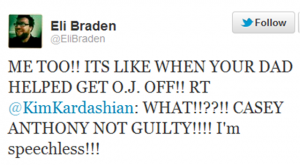I’ll admit it; I’m kind of fascinated by Michele Bachmann. It’s gotten to the point that those close to me are tired of hearing about all the crazy stuff she does.
Every time there’s a headline about some new cringeworthy gaffe she’s made or outlandish position she’s taken, my schadenfreude sense gets all tingly. I totally eat it up and click through and give the news outlet the eyeballs on their page that bring ad dollars that they were hoping to get by focusing on the most outlandish facets of the news in the first place.
But reading the story “Jon Stewart (with help from Jerry Seinfeld) mocks Marcus Bachmann’s gay therapy… as he ‘seems so gay,’” the usual glee I take in the absurdity of the Right vanished.
My first thought was: We’re not doing this. I don’t want to play this game. This is something they do. I like living on the moral high ground, and I want to stay there, thank you very much. No matter how odious the other side may be, no matter how appealing it is to think of giving them a taste of their own medicine.
Of course, as Michelle Cottle at the Daily Beast pointed out, this is
about more than critics lobbing generic bombs at a fiercely conservative presidential combatant. Michele Bachmann has long been one of the most aggressive anti-gay-marriage crusaders in politics, while Marcus runs a Christian-based therapy clinic accused of dabbling in “reparative therapy,” a controversial counseling technique premised on the notion that you can “pray away the gay.”
And there is something compelling about the turnabout here. If people like the Bachmanns didn’t insist that being gay was so horrifying, it wouldn’t be a big deal if he is. So it’s his own fault, too bad, so sad.
Also, the idea that someone is “profoundly antigay” out of gay panic makes a certain amount of sense.The idea that this is a form of protesting too much (and Shakespeare’s original opposite meaning be damned) is well-established. Popular culture has explored it: look at Karofsky bullying Kurt in Glee (or, I know I’m hung up on it, but seriously, Quinn’s mistreatment of Rachel. See skywarrior108’s The Truth About Quinn Fabray.)
But if Karofsky kissed Kurt and Quinn drew a picture of Rachel with hearts around it, where’s the smoking gun with Marcus Bachmann?
It’s his apparently “effeminate manner and ‘center-square gay’ voice” (Cottle). That’s right, they’re reading his sexuality off from his gender. The same way gender non-conforming people have been persecuted as sexual deviants with surprising consistency across time and space (though clearly not everywhere or everywhen).
Seriously? Sexuality doesn’t follow immediately from gender any more than either of them follow immediately from sex. If Marcus Bachmann is swishy, it doesn’t mean he likes men. The same people trying to call him out now have surely defended tough and supposedly “manly” women like Hillary Clinton against accusations of lesbianism, so how is this different?.
Judith Butler, in her 1993 book Bodies that Matter points out that “homophobia often operates through the attribution of a damaged, failed, or otherwise abject gender to homosexuals” (p. 238). People like Dan Savage and Jon Stewart and Andrew Sullivan would probably reject the idea that they’re homophobic (though at least a few queer theorists would disagree about Sullivan), but reading “failed” gender as a sign of homosexuality is the same thing.
That’s because it is based in the (heterosexist) idea that if you like someone of the “same” sex, it means you’re really sort of the “opposite sex” on the inside, because there can only really be cross-sex attraction. This argument is objectionable because it makes heterosexuality central and homosexuality a failed imitation.
Meghan Daum of the LA Times adds an interesting spin to this: “from the looks of things, it isn’t acting gay that Bachmann deplores; it’s gay acts. And there’s no evidence he’s broken his own rules about the latter.” Though problematic in assuming that there’s such a thing as “acting gay,” Daum’s piece usefully preserves the ways in which behaving a certain gendered way is distinct from having particular kinds of sex.
So even if Mr. Bachmann does really want to engage in gay sex—which we have no evidence of—the evidence that we do have points to him not actually doing it. Thus, “even if there were truth to the innuendo, how do you pin hypocrisy on someone who practices what he preaches?” (Daum).
The New York Times had a really interesting article about homosexuality, religion, and therapy recently that talked about the ways that both one’s sexuality and one’s religion tend to be integral parts of one’s identity. Gays assume you can just chuck your religion, and churches assume you can just chuck your gayness, but when people genuinely find both important to them, therapists are finding, the solution is exactly like Daum suggests Bachmann’s practice might be—you can have your desires or your gay identity, but maintain your religious identity by not acting on them. Food for thought, at least.
Self-loathing and unconfessed same-sex desire makes for gorgeously angsty and potentially hot fan fiction in which authors can really explore what it must be like to really want to have gay sex but be unable to reconcile it with your faith or your self-image (it’s a staple of the Quinn character in Rachel/Quinn fiction in the Glee fandom, and some of it is really beautifully done). But we don’t get to play with real people that way.
Okay, we do in Real Person Fiction (RPF). So if it’s really that important to these people, they can write a character study of a fictionalized Marcus Bachmann wracked with same-sex desire and crying himself to sleep at night. They can explore the darkness and pain of that place if it helps them reconcile the things that don’t make sense about his behavior, just like people do with other figures and characters.
But that isn’t news. It’s fantasy. There’s nothing wrong with asking these kinds of “what if?” questions, but it belongs on FanFiction.net or Archive of our Own or whatever political figure fan fiction LiveJournal community.
Because frankly, harassing someone on the basis of sex they do or don’t have, or sex they do or don’t want to have, isn’t okay, no matter who’s doing it.
Hey all, I might miss next week because I’m moving this weekend and then my mother-in-law (out-law?) will be here. But I’ll try.


